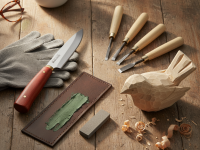Hey there, fellow wood whisperers and miniature magicians! If you’re anything like me, you live for those moments when a delicate curve emerges from a block of wood, or a tiny feather seems to almost lift off the surface. That exquisite feeling of bringing a vision to life, one precise tap at a time. But let’s be honest, those intricate details don’t just happen. They require patience, skill, and perhaps most importantly, the right tools.
And when it comes to guiding your chisels and gouges with the finesse needed for fine detail work, the mallet isn’t just an accessory; it’s a crucial extension of your hand. I’ve spent countless hours in my workshop, experimenting with different woods, varying chisel types, and yes, a whole assortment of mallets. Through trial and error, I’ve discovered what truly makes a mallet sing when you’re trying to carve an iris or define a hair strand. Forget the heavy-duty beasts for roughing out – we’re talking surgical precision here.
So, let’s dive into my personal journey and recommendations for the best wood carving mallet brands that truly shine when it comes to fine detail work. This isn’t just a list; it’s born from actual sawdust, countless gentle taps, and the pure joy of seeing a vision perfectly executed.
Why Your Mallet is a Secret Weapon for Precision
You might think, “A mallet’s a mallet, right? It just hits things.” Oh, if only it were that simple, my friend! For fine detail carving, the choice of mallet can make or break your project, and honestly, your wrist. Here’s why a specialized mallet is absolutely essential for those delicate touches:
- Unrivaled Control: Unlike a conventional hammer, a good carving mallet is designed for balance and feedback. It tells you exactly how much force you’re applying, allowing for minute adjustments to your chisel’s depth and direction.
- Reduced Fatigue: When you’re spending hours on a detailed relief carving, a mallet that’s poorly balanced or too heavy will wear you out quickly. The right mallet feels like a natural extension, minimizing strain.
- Protecting Your Precious Tools: Fine chisels and gouges often have delicate handles and incredibly sharp edges. A mallet designed for carving will deliver a softer, more controlled blow, preventing damage to your tool handles and ensuring consistent edge retention.
- Enhanced Feel and Feedback: The material and construction of a good carving mallet provide excellent tactile feedback. You can literally feel the chisel entering the wood, allowing you to react instantly to the grain and achieve cleaner cuts.
In my experience, trying to use a carpenter’s hammer for detailed carving is like trying to paint miniatures with a house painter’s brush – it’s just not going to give you the results you want. The specific weight, balance, and material of a carving mallet are tailored for this very purpose.
What I Look For in a Fine Detail Mallet
Before we get to the brands, let’s talk about the characteristics that, from my perspective, define an excellent mallet for intricate work. When I pick up a mallet, especially for fine detail, I’m looking for a few key things:
-
The Perfect Weight
This is crucial. Too heavy, and you risk overshooting your mark, damaging your carving, or even splitting delicate wood. Too light, and you’ll struggle to get your chisel to bite effectively, leading to choppy cuts and frustration. For fine detail, I find myself gravitating towards mallets in the 8oz to 16oz range, sometimes even lighter. It’s about finding that ‘sweet spot’ where you can deliver a crisp, controlled tap without excessive effort.
-
Head Material Matters
You’ll primarily encounter wooden or rawhide mallets for carving. For fine detail, I lean heavily towards dense hardwoods like Lignum Vitae, Hornbeam, or even well-seasoned Maple. These woods offer a firm but forgiving strike that doesn’t damage chisel handles. Rawhide mallets are also fantastic for extremely gentle work or when you want absolutely no bounce back, though they tend to be lighter and more suited for ‘push’ carving with a light tap, rather than deeper cuts.
-
Ergonomics and Balance
The handle should feel comfortable and secure in your hand. I prefer handles that are well-turned and smooth, allowing for a relaxed grip. The balance point of the mallet is also important – it should feel balanced, not head-heavy or handle-heavy, allowing for effortless wrist movements. A perfectly balanced mallet minimizes the effort you need to exert.
-
Head Shape
While many carving mallets have round or barrel-shaped heads, some for detail work might have a slightly flatter face or even a tapered design. For my purposes, a simple, well-rounded head works best, as it offers a consistent striking surface regardless of the angle I approach the chisel handle. Square-faced mallets are generally too aggressive for fine detail.
My Top Picks: Brands That Excel for Fine Detail Work
Now, for the part you’ve been waiting for! These are the brands that, through my personal experience, have consistently delivered exceptional performance for intricate wood carving.
1. F. D. Helve & Co. (or similar premium wooden mallet makers like Ashley Iles)
When I first picked up a genuine Lignum Vitae mallet from a reputable, traditional maker, it was an epiphany. Brands like F. D. Helve & Co. (or the mallets often associated with top-tier chisel makers like Ashley Iles or Pfeil) craft mallets that are simply a joy to use. The density of Lignum Vitae is incredible; it offers a firm, yet wonderfully dead blow. There’s almost no rebound, which means all your energy goes directly into the chisel, giving you unparalleled control. I remember working on a highly textured animal sculpture where I needed to create very shallow, precise fur lines. My F. D. Helve mallet allowed me to make countless tiny, consistent taps without ever feeling fatigued or losing control. They are an investment, but one that pays dividends in precision and pure carving pleasure.
2. Stubai
Hailing from Austria, Stubai is renowned for its high-quality carving tools, and their mallets are no exception. I’ve found their smaller, round-headed wooden mallets to be excellent for detailed work. They often use dense woods like Hornbeam or Ash, which provide a good weight-to-density ratio. What I particularly appreciate about Stubai mallets is their ergonomic design; they just feel right in the hand. I’ve used my Stubai mallet extensively for architectural carvings, where crisp edges and consistent depths are paramount. The feedback from the mallet is immediate, letting you know exactly how the chisel is interacting with the wood. They’re a fantastic choice for carvers who appreciate robust quality combined with comfortable handling.
3. Henry Taylor
The name Henry Taylor evokes a sense of tradition and quality in the carving world, and their mallets uphold that reputation. Often made from high-quality hardwood, their smaller, barrel-shaped mallets are superb for detail work. I own a couple of their traditional boxwood mallets, and they’ve become indispensable. They offer a slightly softer blow than Lignum Vitae, which can be beneficial when you’re working with particularly delicate or brittle woods. I recall working on a very detailed floral carving for a client; the subtle, controlled taps from my Henry Taylor mallet allowed me to define the delicate petals and leaves without any risk of bruising the wood. They’re beautifully balanced and feel incredibly responsive.
4. Rawhide Mallets (e.g., Garland or Estwing for general purpose, adapted for carving)
While not a specific “carving brand” in the same vein as the others, a good quality rawhide mallet deserves a spot on this list, especially for the absolute finest detail and finishing work. Brands like Garland or Estwing make excellent rawhide mallets, and while they might be more commonly found in leatherworking or metal shaping, their softer, non-marring strike is incredible for delicate carving. When I’m at the very last stages of a carving, needing to shave off microns of wood or refine a hair-thin line, a rawhide mallet is my go-to. It provides a cushioned blow that minimizes any jarring or potential for splitting, offering maximum control. It’s also excellent for gently seating tools without causing any undue stress to their handles. It’s a different feel – a ‘thud’ rather than a ‘tap’ – but incredibly effective for specific, very light tasks.
My Carving Tips for Using Your Fine Detail Mallet
Having the right mallet is half the battle; knowing how to use it effectively for detail work is the other. Here are a few tips I’ve picked up along the way:
- Light Grip is Key: Don’t white-knuckle your mallet. A relaxed, light grip allows for better control and feel. Let the mallet’s weight do the work.
- Wrist, Not Arm: For fine detail, most of your power should come from your wrist, not your entire arm. This gives you micro-control over each strike.
- Listen to the Wood: Pay attention to the sound your mallet makes against the chisel. A clean, crisp sound usually indicates a good cut. A dull thud might mean you’re struggling against the grain or your chisel isn’t sharp enough.
- Practice on Scraps: Before diving into your masterpiece, always test your mallet and chisel combination on a similar scrap piece of wood. This helps you gauge the required force.
- Keep it Clean: Regularly wipe down your mallet head. Wood dust and oils can build up, potentially affecting the consistency of your strike.
Conclusion: The Mallet – Your Partner in Precision
Choosing the right wood carving mallet for fine detail work is a personal journey, but one that is incredibly rewarding. It’s not just about hitting a chisel; it’s about control, feel, and ultimately, bringing your most intricate artistic visions to life with precision and confidence.
Investing in a high-quality mallet from brands like F. D. Helve, Stubai, Henry Taylor, or even integrating a good rawhide mallet into your arsenal, will transform your detail carving experience. These tools become extensions of your will, translating your lightest touch into beautiful, deliberate cuts.
So, take the time to find the mallet that truly resonates with you. Feel its balance, appreciate its craftsmanship, and let it guide you towards creating masterpieces, one exquisite detail at a time. Happy carving!




